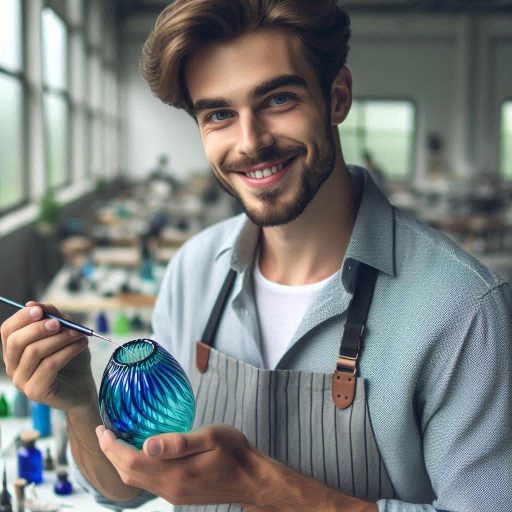Introduction
In this blog post, we will explore Sculptor Pathways to Artistic Career.
As sculptors, the journey towards an artistic career is both challenging and rewarding.
Finding success in this field requires passion, dedication, and a strong work ethic.
One of the biggest challenges sculptors face is the competitive nature of the art world.
With so many talented artists vying for recognition and opportunities, standing out can be difficult.
Additionally, the financial instability that often comes with pursuing a career in sculpture can be daunting.
Despite these challenges, the rewards of a career as a sculptor are numerous.
The ability to bring ideas to life through the manipulation of materials is incredibly gratifying.
Sculptors have the opportunity to create pieces that can evoke emotions, inspire others, and leave a lasting impact on the world.
Furthermore, the freedom and creativity that come with being a sculptor are unmatched.
Artists have the ability to explore different mediums, techniques, and styles to fully realize their artistic vision.
This creative freedom allows sculptors to constantly evolve and grow in their craft.
In this blog post, we will delve into the various pathways sculptors can take to build a successful career in the arts.
From formal education and apprenticeships to self-taught techniques and networking, there are many avenues to explore in order to achieve your artistic goals.
Stay tuned as we explore the possibilities and opportunities available to aspiring sculptors on their journey to a fulfilling and rewarding career in the arts.
Education and Training
Importance of Formal Education in Sculpture or Fine Arts
Formal education in sculpture or fine arts lays the foundation for a successful career.
It offers structured learning and exposure to diverse techniques.
Art schools and universities provide a deep understanding of art history, sculpting methods, and critical thinking.
A degree program often covers drawing, modeling, and contemporary sculpture trends.
Types of Training Programs
Apprenticeships
Apprenticeships allow aspiring sculptors to learn directly from established artists.
Transform Your Career Today
Unlock a personalized career strategy that drives real results. Get tailored advice and a roadmap designed just for you.
Start NowThey provide hands-on experience and mentorship.
Through observation and practice, students develop technical proficiency and artistic style.
Artist Residencies
Artist residencies immerse individuals in creative environments, offering space, time, and resources.
Residencies encourage experimentation and collaboration, helping artists expand their portfolios.
Workshops and Short Courses
Workshops focus on specific techniques like stone carving or metalwork.
They provide intensive, short-term training, perfect for skill-building.
Short courses may focus on new tools, software, or sculpting materials.
Benefits of Continuing Education
Skill Enhancement
Continuing education keeps sculptors up-to-date on industry innovations and techniques.
It offers opportunities to refine existing skills or learn new ones, such as digital sculpting.
Networking Opportunities
Workshops and residencies introduce sculptors to like-minded artists, curators, and potential clients.
These connections can lead to collaborations or career opportunities.
Boosting Creative Confidence
Education and training nurture creative confidence.
A strong educational foundation allows sculptors to push boundaries and experiment with innovative concepts.
In fact, formal education, apprenticeships, and residencies play key roles in shaping a sculptor‘s career.
Continuous learning ensures that artists stay competitive and adaptable in a constantly evolving field.
Read: The Artist‘s Guide to Printmaking Supplies
Developing a Unique Style
Significance of finding one’s artistic voice as a sculptor
As a sculptor, finding your artistic voice is crucial to standing out in a competitive field.
Developing a unique style sets you apart from other artists and creates a signature that is instantly recognizable.
The process of experimentation and exploration to develop a unique style
Experimentation and exploration are key components in discovering your individual style.
By trying different techniques, mediums, and subjects, you can uncover what resonates with you on a deeper level.
Transform Your Career Today
Unlock a personalized career strategy that drives real results. Get tailored advice and a roadmap designed just for you.
Start NowExamples of Famous Sculptors and Their Signature Techniques
- Auguste Rodin: Known for his expressive and emotive sculptures, Rodin’s signature technique involved rough textures and unfinished surfaces to convey raw emotion.
- Barbara Hepworth: Hepworth’s abstract and organic sculptures often incorporated the use of negative space, creating harmonious compositions that emphasized form and balance.
- Constantin Brancusi: Brancusi’s sleek and minimalist sculptures focused on simplifying forms to their essence, conveying a sense of purity and elegance in his work.
- Louise Bourgeois: Bourgeois explored themes of identity and vulnerability in her sculptures, using materials like fabric and metal to create provocative and introspective pieces.
- Henry Moore: Moore’s monumental and figurative sculptures often featured organic shapes and textures, inspired by nature and the human form.
By studying the works of these renowned sculptors, you can gain insight into how they honed their unique styles through experimentation and innovation.
Take inspiration from their techniques, but remember to stay true to your own artistic voice as you carve your own path in the world of sculpture.
Building a Portfolio
Importance of creating a diverse portfolio of work
Creating a diverse portfolio is essential for sculptors seeking to build a successful career.
A well-rounded portfolio demonstrates versatility, showcasing your ability to work with different materials and techniques.
By including a variety of projects, you give potential clients or employers a broader understanding of your skills and artistic range.
Tips on how to showcase different projects, including photographs and videos
When building your portfolio, focus on presenting high-quality photographs of your work.
Clear, well-lit images help capture the details and texture of your sculptures.
Videos can also add value by showing your process and the three-dimensional nature of your work.
Consider creating time-lapse videos of your creations or offering behind-the-scenes glimpses of your techniques.
Role of online platforms and social media in sharing one’s portfolio
Online platforms and social media play a crucial role in sharing your portfolio with a larger audience.
Websites like Behance, ArtStation, or your personal website allow you to organize and display your projects professionally.
Social media platforms, such as Instagram or TikTok, offer an opportunity to engage with a global audience.
By consistently sharing your work, you increase your visibility and chances of being discovered by potential collaborators or buyers.
Keep your portfolio updated with new work to reflect your growth as an artist.
Continuously refine your presentation and adapt to changing trends in art and technology.
A well-crafted, diverse portfolio not only showcases your talent but also sets you apart in a competitive field.
By combining quality visuals, online platforms, and social media engagement, you build a strong foundation for a thriving sculpting career.
Read: Printmaking: Combining Traditional and Digital
Networking and Building Connections
Benefits of networking within the art community
Networking within the art community is essential for sculptors to establish their careers.
- Attend art events, exhibitions, and competitions to meet potential collaborators and clients.
- Join art organizations and clubs to connect with like-minded individuals in the field.
- Utilize social media platforms like Instagram and LinkedIn to showcase your work and connect with others.
- Engage in online forums and groups to seek advice, feedback, and opportunities for collaboration.
How to connect with galleries, curators, and other artists
Connecting with galleries, curators, and other artists can open up new avenues for sculptors.
Transform Your Career Today
Unlock a personalized career strategy that drives real results. Get tailored advice and a roadmap designed just for you.
Start Now- Research galleries and curators that align with your artistic style and reach out to them with a professional portfolio.
- Attend gallery openings and art fairs to establish relationships with curators and gallery owners.
- Collaborate with other artists on joint projects or exhibitions to expand your network and reach a wider audience.
- Participate in artist residencies or workshops to connect with established artists and mentors in the field.
The value of attending art events, exhibitions, and competitions
Attending art events, exhibitions, and competitions can provide valuable exposure and recognition for sculptors.
- Submit your work to juried exhibitions and competitions to gain recognition and build your reputation in the art world.
- Attend art fairs and trade shows to showcase your sculptures and connect with potential buyers and collectors.
- Participate in artist talks and panel discussions to share your insights and expertise with other artists and art enthusiasts.
- Volunteer at art events or festivals to network with industry professionals and gain valuable experience in the field.
Building a strong network of connections within the art community can help sculptors advance their artistic careers and achieve success in their chosen field.
Read: Exploring Cultural Influences in Printmaking

Finding Opportunities for Exhibition and Commission
As a sculptor, one of the most crucial aspects of building a successful artistic career is finding opportunities for exhibition and commission.
Here are some strategies to help you navigate this important aspect of your journey:
Research Local Galleries and Art Spaces
- Visit galleries and art spaces in your area to understand their aesthetic and whether your work would be a good fit.
- Contact them to inquire about submission guidelines and upcoming exhibition opportunities.
Submitting to Juried Shows
- Research juried shows that align with your style and medium of sculpture.
- Prepare a strong portfolio of your work and follow submission guidelines carefully.
- Being selected for juried shows can provide excellent exposure and credibility.
Participating in Art Fairs
- Art fairs are a great way to connect with a wide audience of art enthusiasts and potential buyers.
- Research reputable art fairs in your region and apply to participate as an exhibitor.
- Be prepared to engage with visitors and discuss your work passionately.
Pursuing Public Art Commissions
- Explore opportunities for public art commissions in your city or region.
- Research the application process and requirements, including submitting proposals and budgets.
- Public art commissions can not only provide financial support but also enhance your reputation as an artist.
Building Relationships with Collectors and Clients
- Attend art events, openings, and networking gatherings to connect with collectors and potential clients.
- Engage with them genuinely and share insights into your creative process and inspiration.
- Building strong relationships can lead to repeat sales and word-of-mouth referrals.
By actively seeking out opportunities for exhibition and commission, and nurturing relationships with collectors and clients, you can create a thriving artistic career as a sculptor.
Remember to stay persistent, flexible, and authentic in your journey.
Read: Printmaking Techniques: Photogravure Basics
Managing Finances and Marketing
Tips on pricing artwork, budgeting for materials, and managing expenses
- Calculate your costs accurately to set fair prices for your sculptures.
- Research the market to understand pricing trends and competition in the industry.
- Consider the time and effort put into each piece when determining the price.
- Keep track of expenses such as raw materials, tools, studio rent, and utilities.
- Create a budget that allocates funds for different aspects of your artistic career.
- Look for ways to reduce costs without compromising the quality of your work.
- Explore options for financing your art projects such as grants or crowdfunding.
Role of marketing and branding in promoting one’s work and attracting clients
- Develop a strong brand identity that reflects your unique style and artistic vision.
- Create a professional portfolio showcasing your best work to potential clients.
- Utilize social media platforms to showcase your art, engage with followers, and attract clients.
- Attend art fairs, exhibitions, and networking events to promote your work and build connections.
- Collaborate with galleries, art dealers, and interior designers to expand your reach.
- Consider hiring a professional marketer or PR agent to help promote your sculptures.
- Engage in collaborations with other artists or brands to increase visibility and reach new audiences.
Balancing Creativity and Commercial Success
Challenge of balancing artistic integrity with commercial success
Striking a balance between artistic integrity and commercial success is a common challenge for sculptors.
Artistic integrity involves staying true to your unique style, vision, and creative voice.
On the other hand, commercial success requires understanding market trends and meeting client demands.
Importance of setting goals and staying true to one’s artistic vision
To navigate this balancing act, it’s crucial to set clear goals and objectives for your artistic career.
Define what success means to you personally, whether it’s critical acclaim, financial stability, or both.
By setting specific goals, you can prioritize your efforts and focus on projects that align with your vision.
Remember that commercial success does not always equate to artistic fulfillment or creative satisfaction.
It’s essential to stay true to your artistic vision and integrity, even if it means taking risks or facing challenges.
Don’t compromise your core artistic values for the sake of commercial gain, as authenticity is key to sustained success.
Prioritizing self-care and mental health in a demanding career
While striving for commercial success, prioritize self-care and mental health to avoid burnout and maintain creativity.
Take breaks when needed, practice mindfulness, and seek support from friends, family, or mental health professionals.
Create a healthy work-life balance by setting boundaries, delegating tasks, and allowing yourself time to recharge.
Transform Your Career Today
Unlock a personalized career strategy that drives real results. Get tailored advice and a roadmap designed just for you.
Start NowRemember that your well-being is essential for nurturing your creativity and sustaining a successful artistic career.
Explore Further: Mastering Game Design with Online Courses
Conclusion
The journey to becoming a successful sculptor requires dedication, patience, and perseverance.
It is crucial to continuously develop your skills, experiment with different techniques, and seek inspiration from various sources.
Networking within the artistic community can provide valuable opportunities for growth and exposure.
Don’t be afraid to take risks and push the boundaries of your creativity to create unique and compelling art.
Remember that setbacks and failures are part of the learning process, so embrace them as opportunities to grow.
Above all, stay true to your passion for sculpting and let it be the driving force that propels you forward on your artistic journey.
For aspiring sculptors out there, don’t be discouraged by the challenges that may come your way.
Embrace the process, seek mentorship from experienced artists, and never stop honing your craft.
Believe in yourself and your artistic vision, and you will undoubtedly carve your path to a fulfilling and successful artistic career as a sculptor.




